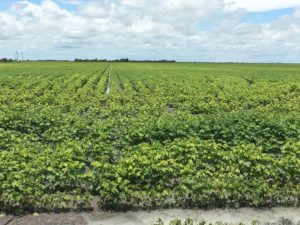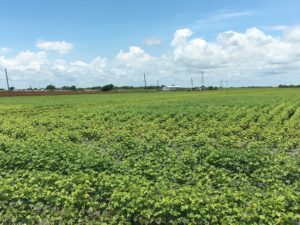by Dr. Gaylon Morgan, Professor and Extension State Specialist, 979-845-2425; gdmorgan@tamu.edu
It has been another wet spring and early summer for the Coastal Bend, Upper Gulf Coast, and Blacklands of Texas. The heavy clay soils in these regions are the lifeblood of crop production in the regions because of high water and nutrient holding capacity. However, these soils also drain slower and excessive rain can lead to prolonged saturated and anaerobic soil conditions. Under the saturated conditions, very little oxygen remains in the soil. Without oxygen in the soil, the plant root respiration and nutrient and water uptake from the soil is substantially reduced. This can lead to nutrient deficiency symptoms in the plant, despite sufficient nutrients in the soil.
During the last week of May and early June of 2016, yellow cotton was widespread across the Coastal Bend of Texas as the crop was loaded with squares and approaching the early bloom stage. See Figure 1 and 2 of cotton fields in San Patricio county. The yellowing symptoms are more prevalent in the poorly drained fields where the soil has remained saturated for 5-10 days. Also, at the current growth stage, the cotton plants have a tremendous nutrient uptake demand, and simultaneously poor conditions for nutrient uptake into the roots. In the majority of the fields, the cotton upper cotton canopy was yellow, while the lower canopy was greener. Nitrogen, Phosphorous, Potassium, and Magnesium (and some others) are plant mobile nutrients and will move from older leaves to newer leaves when insufficient nutrients are available. As a result, N,P,K, and Mg, deficiency symptoms occur on the older leaves of the plant first. Calcium, Sulfur Iron, Zinc, Boron, and some others are immobile in the plant. So, the nutrient deficiencies symptoms of immobile nutrients occur first in the upper leaves, which is the current situation in the Coastal Bend. Specific nutrient deficiencies in cotton can be viewed at IPNI’s webpage http://www.ipni.net/article/IPNI-3327.
Based on previous experience and conversations with people familiar with the Coastal Bend, I would expect the nutrient deficiency symptoms to disappear as the soils dry, oxygen re-enters the soil, and nutrient uptake resumes. Then, nutrient uptake will sufficiently supply the plant needs for mobile and immobile nutrients. The level of yield loss due to the insufficient supply of nutrients is hard to predict and will be more affected by growing conditions the remained of the season. If producers feel the need to try to manage the situation, I suggest collecting some leave samples from the upper leaves in yellow areas of the field and submit the leaves to a laboratory to identify the nutrient levels. Then, foliar applications of the limited nutrient(s) could be applied, if necessary. Adequate levels of micro-nutrients (Zinc, Boroon, Iron, and others) can be accomplished through foliar applications. If foliar applications are going to be applied, then I encourage leaving at least one untreated strip in the field. This will allow the farmer to assess whether the foliar nutrient applications were a good choice based on visual observations and yield.
For any questions, please do not hesitate to call or email me.

Dr. Gaylon Morgan
State Extension Cotton Specialist
College Station, TX
979-845-2425
gdmorgan@tamu.edu

